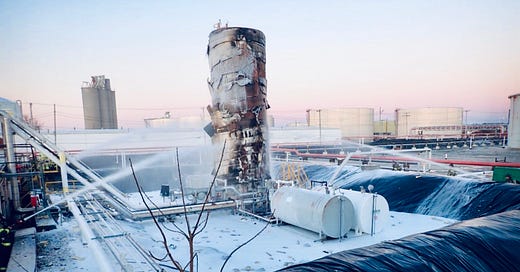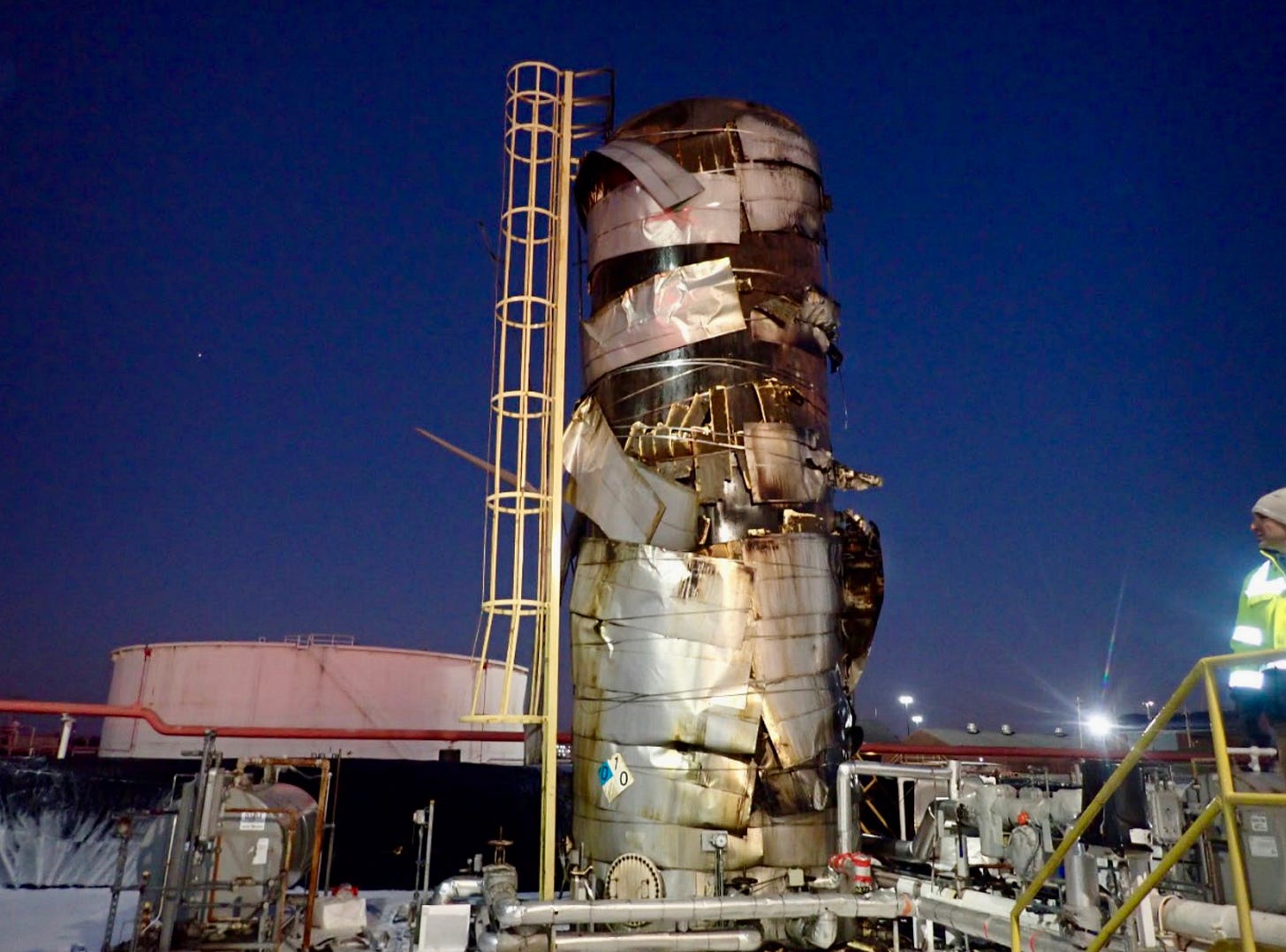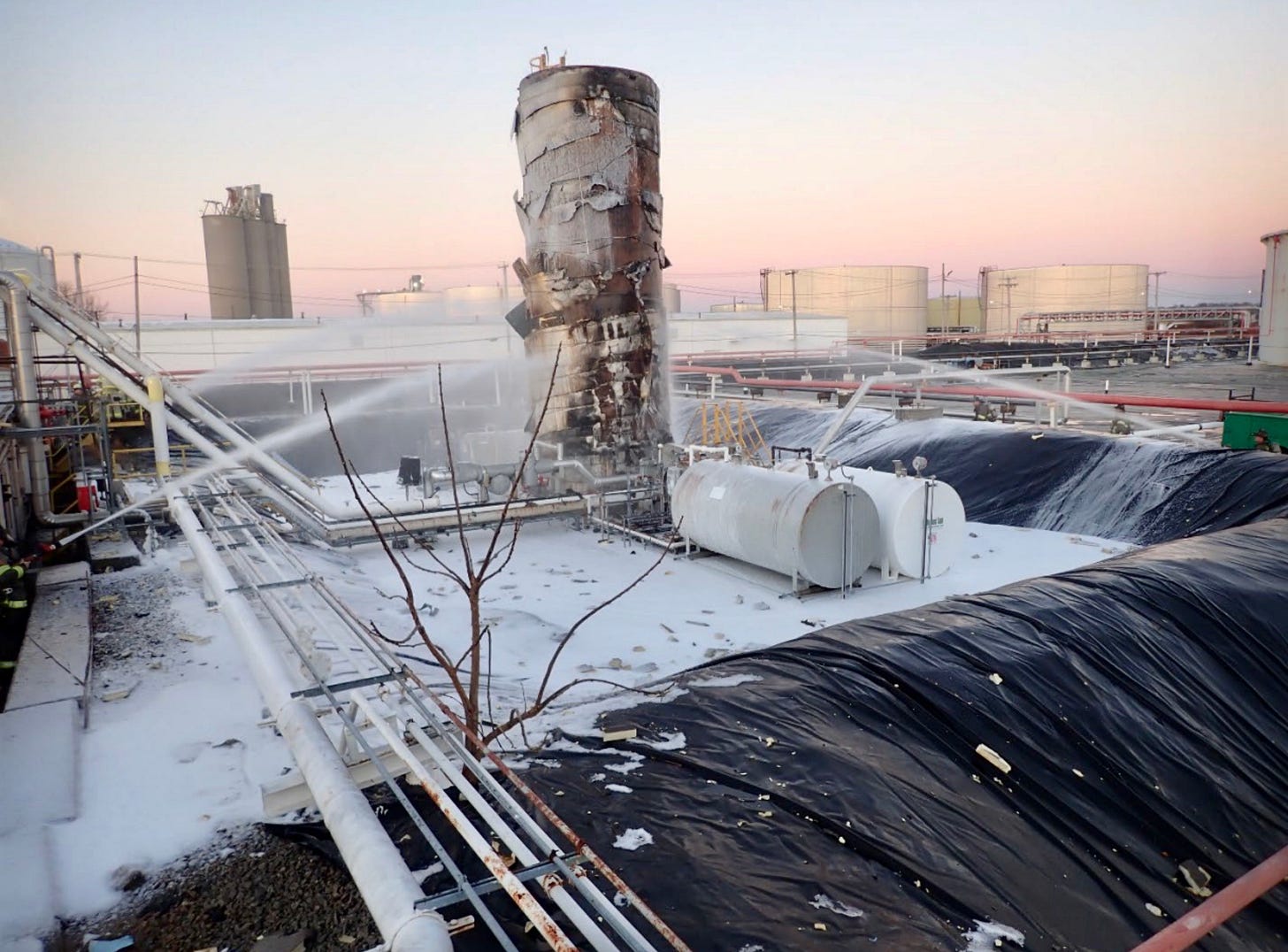Few answers for the public regarding the biofuel tank explosion in ProvPort
"...you’re dealing with things that can go boom," said Washington Park Resident Linda Perri. "Maybe this was a small thing. It wasn’t LNG, but it was a big deal. I mean, you can’t sugarcoat it.”
The Providence Fire Department released their field notes regarding the bio-fuel container explosion and fire that rocked ProvPort the day after Christmas last year.
“Investigators determined the fire originated in a distribution tank of biofuel,” read the report by Fire Investigator Eric Pedro. “The cause of the fire was determined to be possibly a damaged heating coil in the system igniting the biofuel vapors in the tank. The first fuel ignited was determined to be vapors from the bio-fuel in the tank. The ignition sequence was possibly a damaged heating coil in the distribution tank that brought available vapors from stored biofuel to their ignition temperature.”
The full report is in the footnote.1
On Tuesday, Providence City Councilmember Pedro Espinal (Ward 10) held a community meeting at the Washington Park Library to discuss the fire. Here’s the video:
“The fire report from the fire that happened at 130 Terminal Road is what we would refer to as an overpressurization,” said Fire Chief Derek Silva, explaining the rough findings of the investigation. “We theorized and believe the cause is that there was an over-pressurization in the piping for that tank, which damaged some heating coils, and we believe what happened was the tank superheated and eventually ignited.
“While it looked sensational and looked as if the entire port was on fire, realistically, it was confined to that one individual tank and surrounded by berms that would contain any fuel spillage, leakage, or, for our purposes, any of the firefighting foam or, the water we utilized that was contaminated. That all gets held within that berm.
“That explosion or over-pressurization was the top of the tank popping off, which, as crazy as it looks, and as sensational as it looks, is how the tank is designed to work. The idea behind that is with the top coming off, the sides don’t blow out and perhaps hit another tank, injure humans, or damage any buildings or vehicles around.
“When the fire department does an investigation, the important piece is the cause and origin and what we call incendiary. What we’re trying to rule out is whether it was intentionally ignited. Were there any malicious reasons for it occurring? By the investigator’s report, none of that was found. This was just an unfortunate accident.”
A Washington Park resident who identified himself as an engineer had questions.
“Have you done a root cause analysis to determine if it had something to do with the operators? Was it a manufacturing issue? Is it a design failure?” he asked. “Coils heating up over pressurizing cold winter? Some things just don’t make sense to me. So maybe you can connect the dots for me and provide insights as to what your investigation provided regarding results and what you will do to prevent future accidents.”
Company spokespeople could not answer most of these questions, saying that they are still working through their internal investigation and that operating procedures were in place and mostly prevented worse outcomes.
Linda Perri, who heads the Washington Park Neighborhood Association, wanted to know if the facility’s age—built around 2007—was related to the accident.
“Do you think it was old equipment? Because from what I gather, that’s been there since 2007. I don’t know how often it’s inspected. I don’t know how deep the inspections are, but you’re dealing with things that can go boom. Maybe this was a small thing. It wasn’t LNG, but it was a big deal. I mean, you can’t sugarcoat it.”
Following Linda Perri’s line of questioning, I asked, “Was age possibly a factor in what happened? Are there older tanks in the Port of Providence? Are there a lot of other tanks that are potentially older and could have similar problems, and we’re just waiting?”
This prompted Christopher Waterson, President and CEO of Waterson Terminal Services, the company that runs ProvPort, to speak up from the audience. After some back-and-forth, he confirmed that other tanks older than the failed tank are in operation in ProvPort.
“From a ProvPort perspective,” said Waterson, “Our leases say that all our tenants must comply with all laws, regulations, safety protocols, and everything like that... We are looking at that lease language, and through our Master Plan Process, that type of language might get updated over time. But like I said the last time about existing leases. It takes two signatures to change a lease, right? Ours and the tenants. So we need to work with our tenants, and we’re fully expecting to do that here at Global.”
Julian Drix, Chair of the Providence Sustainability Commission and Washington Park Resident summed up the community’s questions and angst:
“This is not the first time there’s been some kind of accident, disaster, or emergency in the Port area just over the past 10 years. I think it’s the first time that it’s been a ProvPort facility. The other times, it’s been one of the facilities further up Allens Ave - whether that’s the pipeline rupture near the hospitals, multiple tanker truck spills, or the time the train derailed onto Allens Ave.
“I know there’s many different facilities, there’s a lot of details around the different types of risks there, and that some of the things that are in that area, including some of the other facilities in ProvPort, are regulated under the EPAs risk management plan - I don’t believe that your facility is - but the risk management plan requirements are considered such high risk [from] potential terrorist threats that you have to go to a special EPA facility in Boston and show your ID to look at what the response plans are for worst case scenarios.
“I don’t think what happened here was a worst-case scenario, but it was really bad. I think it should have been prevented, but there were multiple points where prevention failed. This was not prevented - not just once but twice. I read the fire report last night, and it sounds like, and correct me if I’m wrong, there was the initial explosion, and an employee went out, climbed the ladder, and used a fire extinguisher to put out a fire. Then the fire department came, and it was around half an hour or so later, after they had left, that they had to be called back again because the larger fire broke out.
“I am concerned about why those things happened the way they did, why that wasn’t prevented, and what you’re going to do to fix that. This is a learning experience about what went wrong and how we ensure it doesn’t happen again. Is that the protocol for the employee who went up there on the ladder with a fire extinguisher? They risked their life doing that. That could have been so much worse.
“The fire department came, assessed the situation, and left. Why did no one recognize that a much larger fire was about to break out?
“The Univar facilities are across the street. That facility is one of those risk management and regulated facilities with much more severe impacts regarding some of the chemicals stored there if they had been released.
“The misinformation - not just the lack of communication, but what did get communicated was misinformation. People were saying that this was a corn oil storage tank. Corn oil, to me, reads as food grade - you think of cooking oil, you think of food grade consumer goods - which, when I saw that in the news, I was confused because I didn’t think we had any food grade facilities in the Port area. But it turns out it was a fuel-mixing biofuel distribution tank. Why was that misinformation not corrected? From when this happened in December until now, what are we almost in March? Why did it take so long for that to get out? Is it because calling it a fuel explosion sounds worse from a PR standpoint than calling it corn oil?
“When was the last inspection of this tank? Are these self-inspections where, because DEM is understaffed and under-resourced, they rely on facilities to self-inspect and report? When is your lease up for renewal? How much longer do we have to put up with not just this fuel tank but the asphalt, the bitumin products that you import, and the odor issues we deal with constantly - every time the wind is blowing from your facilities to the community and that horrendous sulfur odors we deal with consistently and DEM has not been able to address sufficiently.
“There’s a host of questions here, and it doesn’t seem like you are prepared... I haven’t heard anything that says there’s a competent response to prevent this from happening in your facility or the other one.”
Providence Fire Department Field Notes
Date: 26Dec2024
Time: 15:04
Address: 130 Terminal Rd
Incident No.: 2024-45273
Investigator: Eric Pedro
SUMMARY
On December 26, 2024, at approximately 15:30 hours, Fire Investigators from the Providence Fire Department responded to 130 Terminal Road to conduct a fire scene investigation.
Investigators determined the fire originated in a distribution tank of biofuel. The cause of the fire was determined to be possibly a damaged heating coil in the system igniting the biofuel vapors in the tank. The first fuel ignited was determined to be vapors from the bio-fuel in the tank. The ignition sequence was possibly a damaged heating coil in the distribution tank that brought available vapors from stored biofuel to their ignition temperature.
OVERVIEW
This report is intended to document the investigative efforts of the Providence Fire Department and the investigator’s origin and cause analysis. It should be noted that this report does not, nor was it intended to, contain every investigative detail considered a part of the origin and cause analysis. Rather, this report highlights and summarizes the information and evidence available to investigators that is believed to be the most significant to the origin and cause analysis. As a result, this report should not be a substitute for a deliberate, reasoned discussion with the author and other participating investigators.
The investigation was conducted in compliance with the requirements of NFPA 1033, “Professional Qualifications for Fire Investigator,” 2022 Edition, and NFPA 921, “A Guide for Fire and Explosion Investigations,” 2024 Edition.
The investigative team included Fire Investigator Eric Pedro.
On December 26, 2024, at approximately 15:04 hours, the Providence Fire Department responded to Global Co. LLC at 130 Terminal Road for a reported tanker fire. Chief Jackson in Division 1 was the incident commander, and Lt. Whalen in Engine 13 was the first arriving company officer.
No injuries were reported to investigators.
SCENE INVESTIGATION
The distribution tank at 130 Terminal Road that the fire started in was approximately 40 feet tall and 12 feet across, with a circumference of approximately 38 feet. This tank appeared to be a metal cylinder with a layer of insulation, an outer layer of aluminum sheeting and wrapped with metal cable. There was a ladder that ran up the entire height of the cylinder and extended approximately 5 feet above the tank. At the base of the tank was a large framework of piping and valves that appeared to connect the tank to the distribution portion of the facility. This tank was used to take the product from the larger tanks, where it was then pumped into vehicles and mixed to the proper percentages for transport to the customers.
The facility was owned by GlobalGlo. LLC.
Based on my personal observations of the weather conditions at the time of the fire, it was determined that the weather did not play a role in this fire. According to www.wunderground.com, the weather conditions in Providence around the time of the fire were:
Temperature: 28 degrees Fahrenheit
Humidity: 66 %
Barometric pressure: 30.34 in
Skies: Cloudy
Winds: NNW @ 7 mph
Our exterior examination was unremarkable with the exception of a distribution tank of bio-fuel. The distribution tank was approximately 40 feet tall and 12 feet across, with a circumference of approximately 38 feet. The tank showed damage to the exterior metal sheeting that covered the outside of the tank, as well as the insulation of the tank. There was some possible soot deposition located at the very top of the tank, although this could have also been discoloration of the metal from flame impingement.
Our interior examination was unremarkable.
INTERVIEWS
[REDACTED} Regional Manager Global Co. LLC. [REDACTED} explained to investigators what the contents of the tank were as well as the operation that was being performed when the incident occurred. [REDACTED] told the investigator that a storage tank held bio-fuel was transferring fuel to the tank that had the incident, which was a distribution tank. The fuel is then pumped from the distribution tank into vehicles where it is mixed with heating fuel and then transported to the customer. [REDACTED] stated that when the employee opened the valve to transfer fuel from the storage tank to the distribution tank, there was a loud noise, so the employee closed the valve. The pressure blew the lid off of the tank, sent it into the street and a fire started at the top of the tank. He stated the employee grabbed a fire extinguisher and put out the fire. stated that the fire ignited possibly due to a heating coil that was damaged with the pressure wave that ignited the contents of the tanker. then directed the investigator to the employee [who] was performing the transfer when the incident occurred.
[REDACTED] was the employee[who] performed the transfer operation from a larger tank to the smaller tank that the fire occurred in when the incident happened. [REDACTED] told investigators that around 2 PM he attempted to transfer more fuel to the smaller distribution tank. He stated that when he opened the valve he heard a large wave of pressure, and immediately closed the valve. He said after the valve was closed he heard a loud boom and the lid of the tank shot off and he saw a small fire at the top of the tank. [REDACTED] stated he ran over grabbed an extinguisher climbed the ladder to extinguished the fire.
[REDACTED] believes he successfully extinguished the fire and immediately called the emergency numbers to alert workers of the incident.
Lieutenant Whalen of Engine 13 stated to investigators that they were called to the scene at 130 Terminal road for reports of a possible tank fire on the premises. When they arrived on scene they were met with company employees, who stated that the fire at the top of a bio-fuel storage tank was extinguished by one of the workers. The Lieutenant stated that they remained on scene for roughly 30 minutes speaking with employees. The Lieutenant stated they checked the area for extension and damage to surrounding structures and found none.
Lieutenant Whalen stated that they returned to the station and called the Regional
Manager [REDACTED] to ask how many gallons of bio-fuel the tank was holding. The manager told him that he wasn’t sure but one of the employees told him one
of the pipes to the tank was currently at 300 degrees. The Lieutenant told [REDACTED] they would head back over, but before they made it back to the scene, [REDACTED] stated the tank was on fire again.
Lieutenant Whalen told investigators that his company grabbed a hydrant on the way onto the premises to give themselves a water supply. He stated he had his crew grab a 2 ½ inch hose line and sprayed the sides of the tank to cool the product and protect exposures.
Based on witness interviews, observing and evaluating fire effects and patterns, and considering fire dynamics investigators ’ area of origin of this fire was in a tank of bio-fuel used for distribution to vehicles for transport.
CONCLUSION
Based on interviews with employees of Global Co. investigators determined the cause of the fire to possibly be a damaged heating coil in the distribution tank, brought available vapors from stored bio-fuel to their ignition temperature.
Investigators found no other competent ignition sources in the area of origin.
The first fuel ignited was determined to be vapors from the bio-fuel stored in the tank. The ignition source was determined to possibly be the damaged heating coil in the system. The circumstances that brought them together possibly include a damaged heating coil resulting from a pressurizing event in the system brought available vapors from the bio-fuel stored in the tank to their ignition temperature.
My findings, opinions and conclusions are based on scientifically accepted and well documented indicators, and are within reasonable degree of fire science certainty. This report was based on the information made available to me at the time of its completion. If and when more information becomes available to me, I reserve to amend my opinion as stated above.
Eric Pedro, Fire Investigator







having read ther fire department report, the fire department madxe a big time mistake. And every tank along the waterfront in PVD needs gto be reimpected much more frequently.